Monday 18 August 1941
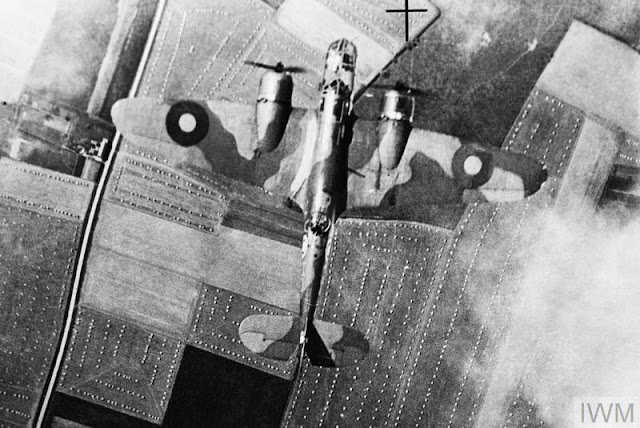 |
| "A Bristol Blenheim Mark IV of No. 226 Squadron demonstrates the effectiveness of its camouflage as it flies over the English countryside, 18 August 1941." © IWM (CH 8605). |
Eastern Front: In the Far North sector on 18 August 1941, German XX Mountain Corps launches a renewed offensive toward Murmansk. It makes no progress against fierce Soviet resistance.
Finnish 18th Division consolidates its newly won bridgehead across the Vuoksi River. The Finns remain on the move in the Karelian Isthmus but are blocked everywhere else. The Finnish troops are getting worn out, too, because, aside from the Soviet resistance, the terrain of forests and swamps and few towns make supply difficult and rest impossible. The Finns are building roads to carry artillery. The Germans are completing the transfer today of 169th Division in a 110-mile march in order to replace the Finnish 6th Division. The march is so long because it involves marching in a roundabout fashion to confuse any Soviet spies.
Colonel-General Nikolaus von Falkenhorst, commander of Army of Norway, (Armeeoberkommando Norwegen, or AOK Norwegen), is not the most tactful of generals. He visits 36 Corps headquarters today and gets into an argument with General Hans Feige, implying that Feige's request for additional troops to continue the offensive is unnecessary. Due to Falkenhorst's pressure, the 6th Division is planning an offensive on the 19th in the Salla sector toward Lehtokangas and Nurmi Mountain. Feige points out that while his forces may have rough parity with the defending Soviet troops, they are receiving reinforcements while his troops are not - a fairly common situation across the entire Eastern Front.
In the Army Group Center sector, the Soviets have infiltrated small forces behind the army group's right flank in the Pripet Marshes. While not a serious threat, these small groups (roughly battalion size) disrupt rear areas that should be quiet and disrupt supplies. There are heavy Soviet attacks north of the main road to Moscow against the 161st Division.
In the Army Group South sector, SS officer Kurt "Panzer" Meyer turns a reconnaissance-in-force of the approaches to the town of Cherson (Kherson) into an all-out assault. He leads his small force down from the heights above the busy town and attempts a "coup de main." His small force takes the Soviet defenders by surprise by sneaking into town along a small road along the Dneipr rather than from the road from Nikolayev (i.e., from the west). The reconnaissance turns into an all-out battle for control of the heart of the city, with Soviet artillery from the east bank of the river forcing Meyer's men to dismount as infantry.
The Romanian 4th Army continues attacking across the Odessa perimeter. Both sides are taking heavy casualties, and progress is slow. The Soviets have nowhere to run and know they will likely be shot if they somehow do make it back through German lines, so they stand and fight.
German Panzer Group 1 (von Kleist) establishes a bridgehead across the Dneiper at Zaporozhye (Zaporizhzhia). The Soviets dynamite the Dneipr Hydroelectric Station to swell the river, causing widespread death and destruction, but the Germans get across anyway. German 50th Division reaches the Black Sea Coast at Ochakov.
Lt. Max-Hellmuth Ostermann of 7./JG 54 shoots down two Russian I-16s over Leningrad.
The Red Air Force raids Berlin with five bombers. Today is the last of a series of small-scale Red Air Force raids against the Ploesti, Romania oil fields.
European Air Operations: During the day, the RAF sends 39 Blenheim bombers on a series of coastal sweeps over Holland and a Circus mission over Lille and Marquise. The pilots claim to sink two trawlers and to bomb Lille, for a cost of one Blenheim.
By prior arrangement between the RAF and Luftwaffe, the RAF successfully drops a spare prosthetic leg for captured RAF Wing Commander Douglas Bader while flying over St. Omer airfield. The Germans are somewhat nonplussed when the charitable gesture is followed by the RAF planes attacking the airfield.
After dark, RAF Bomber Command attacks Cologne and Duisburg. These cities both have been bombed recently so these can be considered follow-up raids.
The RAF puts 62 bombers (42 Hampdens, 17 Whitleys, and 3 Wellingtons) over Cologne. The RAF loses 5 Whitleys and a Wellington. The attack achieves little, with no casualties and only one casualty.
The RAF puts 41 Wellingtons over Duisburg, losing two planes. The weather is clear, so the attack on railway yards is a success.
There is a minor raid by 11 Whitleys and 7 Wellingtons to Dunkirk, and one training sortie over Europe, both without loss.
The Luftwaffe sends a few bombers across to raid the Tyneside and Teesside areas. These are pinprick raids that occasionally hit a populated building, tonight West Hartlepool suffers a tragedy when an ambulance depot is hit with 23 people killed and 45 injured. In addition, about 100 people are made homeless. In Norton, bombs hit a house on Benson Street, killing three people, while next door three others are killed.
David Bensusan-Butt, a civil servant in the War Cabinet Secretariat and an assistant of Lord Cherwell, chief scientific advisor to the Cabinet, submits his "Butt Report" on the accuracy of RAF bombing. The results are startling because they conclude that bombing accuracy is horrendous. Among the more prominent conclusions of the report:
Fortunately for the British, they have navigational aids such as GEE, Oboe, H2S, and other navigational aids in various stages of development. In fact, today RAF Bomber Command orders GEE (the codename for a long-range navigational aid) into production at Dynatron and Cossor.
Battle of the Baltic: Soviet destroyer Statnyi hits a mine and sinks in Moon Sound off Saaremaa (Oesel).
The Luftwaffe attacks Leningrad harbor and sinks 2170-ton Soviet freighter Axel Carl.
Battle of the Atlantic: At 02:50, U-38 (KKpt. Heinrich Schuch), on its 11th patrol out of Lorient and operating with wolfpack Grönland, torpedoes and sinks 1700-ton Panamanian-flagged (but actually controlled by the United States) freighter Longtaker (previously Danish ship Sessa) midway between the southern tips of Greenland and Iceland (300 nautical miles or 560 km southwest of Iceland). The ship goes down in only one minute and most of the crew, 24 men, perish. After nineteen days at sea, US destroyer USS Lansdale picks up three surviving crew (the Danish first officer, a Swede, and a Portuguese crewman - two Portuguese and a Canadian perish while they await rescue) on 5 September. The ship's cargo holds supplies for the US garrison on Iceland. The Danish officer, Hendrik Bjerregaard, maintains a log that receives widespread publicity in the American media.
This is U-38's final victory of the war, though it does go on one more patrol for an even dozen. During its time in service, U-38 sinks 35 commercial ships of 188,967 tons and damages one ship of 3,670 tons.
Royal Navy destroyer HMS Quorn its a mine between Chatham and Harwich. Quorn makes it to Chatham for repairs completed on 13 September.
Convoy HG-71 departs from Gibraltar bound for Liverpool. A Luftwaffe Junkers Ju-88 spots convoy OG-71 shortly after it leaves port and radios in its position.
Royal Navy destroyer HMS Badsworth (Lt. Commander Michael S. Townsend) is commissioned and destroyer Mahratta is laid down.
Canadian minesweepers HMCS Fort William, Kenora, and Milltown are laid down in Port Arthur, Ontario.
Free Netherlands destroyer depot ship HNLMS Columbia (Commander Cornelis Hellingman) is commissioned.
Destroyer USS Badsworth is commissioned.
U-188 is laid down.
Royal Navy submarine HMS P-33 (Lt R. D. Whiteway-Wilkinson DSC), operating off Tripoli and with 32 crewmen, disappears on or around 18 August while attacking an Italian convoy. This is one of the unsolved disappearances of submarines that are common during World War II. An Italian Cant Z501 is flying overhead and sends a ship to look for survivors that the plane's crew see in the water, but it is unclear if it sees survivors of P-33 or another ship. It is assumed by some that P-33 is destroyed by a depth charge attack by an Italian torpedo boat either today or on 23 August, but there is no confirmation of that. Nobody survives.
Royal Navy submarine P-32 (Lt. D. A. B. Abdy)is operating near P-33 and surfaces while an Italian depth charge attack is underway nearby. It is very close to the entrance to Tripoli Harbor. Lieutenant Abdy attempts to run under a known minefield to get into a better firing position but surfaces too soon and P-32 hits a mine. This sends P-32 to the seafloor at a depth of 210 feet with the entire area forward of the control room flooded, killing 8 crew. Abdy manages to escape through the conning tower hatch along with Coxswain E. Kirk, but the rest of the crew in the engine room proves unable to use their escape hatch for some reason. This is likely because an iron bar may have been welded over the rear hatch (though this is not proven). The commander of the Italian ship that picks up Abdy and his mate agrees to stick around to await more survivors, but nobody else gets out. It one of the most dramatic escapes from a submarine during the entire war, as a depth of over 150 feet is considered fatal. A total of 30 men perish.
There are still thousands of Commonwealth troops hiding out on Crete. Royal Navy submarine Torbay (Lt. Comdr. Miers) enters Messara Bay and picks up 28 British and 12 Greek soldiers. Torbay stays in the area submerged on the seafloor and enters the bay again on the 19th, picking up an additional 92 men and returning them to Alexandria.
Royal Navy submarine Tetrarch fires torpedoes into Benghazi Harbor, damaging the port boom defense.
The RAF based on Malta bombs Tripoli with five Wellington bombers.
Royal Navy destroyers Jackal and Kingston make the nightly supply run from Alexandria to Tobruk and back without incident. The relief of Australian troops is in progress, with replacement Polish soldiers landed.
The retreating Soviets scuttle freighter Volochaevka at Cherson.
Soviet auxiliary minesweeper T-503 is lost on this from unknown causes.
Propaganda: Joseph Goebbels calls President Roosevelt the "agent of international Jewry."
US/Finnish Relations: The Soviet Union uses US Secretary of State Sumner Welles as an intermediary to discuss peace terms with Finland. The Soviet proposal is to modify the Peace of Moscow of 1940, which ended the Winter War, to grant Finland some concessions. Finnish Ambassador Hjalmar Procope replies to Welles that the future of Finland depends upon what happens to the Soviet Union after the war, and requests a guarantee to Finland from the Western powers that they will protect Finland if Germany loses the war (which nobody expects at this point). Welles refuses to even consider such a guarantee. The peace feelers go no further.
US/Japanese Relations: At 16:00, Ambassador Grew meets with Foreign Minister Toyoda in Tokyo. Toyoda speaks for two and a half hours straight. He defends Japanese actions in the Pacific and denies that Japan is acting in concert with Germany and says its only objective is the settling of issues in China. For these reasons, a summit meeting between the leaders of the two powers should occur. Grew responds that the Japanese position has not responded adequately to President Roosevelt's concerns, but he will forward the Japanese request for a summit meeting to the US government with his personal support (which he does).
German/Finnish Relations: The Germans confer the Knight's Cross (Ritterkreuz) on Marshal Mannerheim.
Anglo/US Relations: President Roosevelt's White House issues a statement announcing that the US will institute an air transport service from the United States to Africa via Brazil, thence to Egypt. A new aerial "ferry service" is to link up with this in order to deliver military planes to Egypt for the British. The statement reads in part:
The ferry service supposedly derives from a request by Winston Churchill at the Atlantic Charter conference and a subsequent meeting between Roosevelt and Pan Am chairman Juan Trippe on or about 18 August 1941. However, as indicated by the earlier formation of the Pan Am corporations, the idea actually has been under consideration for some time and the conference itself is just a formality to finalize it.
US Military: The War Department asks the Coast Guard to help with national security by patrolling the sea lanes in Alaskan waters and keeping them open.
The US Marine Corps 1st Defense battalion arrives at Wake Island aboard US freighter Regulus (AK-14).
Japanese Military: The Imperial Japanese Navy requisitions 10,020-ton tanker Shinkoku Maru and puts it under the control of the Kure Naval District.
US Government: President Roosevelt signs into a law a modification of the 1940 Selective Service Act that extends the term of service of inductees from 12 to 30 months. The bill passed the House of Representatives by only one vote because there is widespread opposition throughout the country to any peacetime draft.
Congressman John Dingell of Michigan sends President Roosevelt a letter in which he proposes to take 10,000 Japanese-Americans in Hawaii as hostages for Japan's "good behavior." This is the earliest suggestion of incarcerating Japanese-Americans.
British Government: Following the Atlantic Conference in Placentia Bay, Newfoundland and a brief stop in Iceland, Prime Minister Churchill returns to Scapa Flow, Scotland aboard battleship HMS Prince of Wales.
Burma: The Japanese have heard about the American Volunteer Group (AVG, or "Flying Tigers") assembling at Kyedaw, Burma, so they send a reconnaissance plane overhead.
Holocaust: Following a widely discussed series of sermons in German churches condemning euthanasia, Hitler orders a halt - or, more accurately, a pause - in the program. About 50,000 mentally challenged and elderly people have been put to death under the program, including a relation of Hitler himself.
Hitler orders the deportation of what remains of Berlin's Jews to the East.
The concentration camp at Amersfoort, Netherlands, opens.
Brazilian Homefront: A Lockheed 18-10 Lodestar operated by Panair do Brasil crashes into Serra da Cantareira on approach to São Paulo at night. Five of nine passengers and one of four crew members survive the crash. Note that this is one day after Walt Disney and party arrives by air at Rio de Janeiro on a goodwill trip for the US government.
German Homefront: "Swing Kids" (Swingjugend) dancing has become an underground phenomenon in the Reich, and the government is not happy at this intrusion of what it considers a decadent foreign culture. The Swing Kids listen to American and British records, tend to have long hair, dispute authority, and mock military customs such as the Hitler Salute. In general, the police forces (led by Reinhard Heydrich) see this as a dangerous infusion of "anglophile tendencies" that cannot be tolerated.
Today, the police decide to end this scourge. They send men into the clubs, arrest over 300 Swing Kids, and institute various punishments against them. These punishments range from sending the kids back to school or to concentration camps. Some boys are sent to the youth camp at Moringen and girls to the women's camp at Ravensbruck. This incites further resistance by Swing Kids who aren't captured, of course, and they begin doing anti-government acts like handing out anti-fascist leaflets.
Yugoslavian Homefront: Radio Belgrade (Soldatensender Belgrad (Soldiers' Radio Belgrade)) plays a second-hand record collected by a lieutenant on leave in Vienna. It is "Lili Marleen" (aka "Lili Marlen," "Lilli Marlene," and "Lily Marlene," "Lili Marlène" and various other permutations) sung by Lale Andersen. The record was in the bargain bin after selling only 700 copies in its release in 1939. The station only has a few records to play, so it plays "Lili Marleen" over and over and over.
Joseph Goebbels hates the song and demands Radio Belgrade to stop playing it. However, Axis soldiers across the Mediterranean hear the song and love it, including General Erwin Rommel. He asks the station to continue playing the song. Goebbels, who is a friend of Rommel's, relents and allows the song to be played. The song becomes the sign-off tune of the station at 21:55 every night, and soldiers on both sides start to tune in at that moment to hear the song every night. It becomes the most famous song of the war and sells over a million copies.
Contrary to popular belief, the famous version of "Lil Marleen" is not by Marlene Dietrich, though she does record a version (retitled "Lili Marlene" in her honor) for the Morale Operations Branch of the U.S. Office of Strategic Services (OSS) in 1944.
Dutch Homefront: The German occupation authorities suppress what remains of the Dutch government and impose a strict occupation government.
British Homefront: The newly organized National Fire Service - which combines numerous previously independent local fire departments into one seamless organization - comes into being under Sir Aylmer Firebrace, a former London fire chief. The 118,000 men in 1400 local fire brigades, with 180,000 auxiliaries and 60,000 women, are combined into 200 "divisions" and 37 "fire forces." This became necessary because some local fire departments were refusing to come to the aid of local municipalities out of fear that their own towns might be hit. In addition, there were stories of extortion by some fire departments in exchange for providing fire services.
American Homefront: Chesty Manly, the Washington, D.C. correspondent of the Chicago Tribune, publishes a story claiming that a "leak" has informed him that President Roosevelt has plans to send an American expeditionary force to Europe. The story creates an uproar in the capital, and a vigorous debate breaks out in the press about the truthfulness of the story. It is one of several stories run by the isolationist Manly that is of questionable veracity.
The Reverend John A. O'Brien makes a radio address that urges the world to "choose the road to peace." He rhetorically asks what the warring powers have accomplished by two years of war and deplores war's futility. He concludes with a plea to President Roosevelt to put his power "into the Christ-like work of halting the brutal European strife."
August 1941
August 1, 1941: More Executions on Crete
August 2, 1941: Uman Encirclement Closes
August 3, 1941: Bishop von Galen Denounces Euthanasia
August 4, 1941: Hitler at the Front
August 5, 1941: Soviets Surrender at Smolensk
August 6, 1941: U-Boats in the Arctic
August 7, 1941: Soviets Bomb Berlin
August 8, 1941: Uman Pocket Captured
August 9, 1941: Atlantic Conference at Placentia Bay
August 10, 1941: Soviet Bombers Mauled Over Berlin
August 11, 1941: Rita Hayworth in Life
August 12, 1941: Atlantic Charter Announced
August 13, 1941: The Soybean Car
August 14, 1941: The Anders Army Formed
August 15, 1941: Himmler at Minsk
August 16, 1941: Stalin's Order No. 270
August 17, 1941: Germans in Novgorod
August 18, 1941: Lili Marleen
August 19, 1941: Convoy OG-71 Destruction
August 20, 1941: Siege of Leningrad Begins
August 21, 1941: Stalin Enraged
August 22, 1941: Germans Take Cherkassy
August 23, 1941: Go to Kiev
August 24, 1941: Finns Surround Viipuri
August 25, 1941: Iran Invaded
August 26, 1941: The Bridge Over the Desna
August 27, 1941: Soviets Evacuate Tallinn
August 28, 1941: Evacuating Soviets Savaged
August 29, 1941: Finns take Viipuri
August 30, 1941: Operation Acid
August 31, 1941: Mannerheim Says No
2020
Finnish 18th Division consolidates its newly won bridgehead across the Vuoksi River. The Finns remain on the move in the Karelian Isthmus but are blocked everywhere else. The Finnish troops are getting worn out, too, because, aside from the Soviet resistance, the terrain of forests and swamps and few towns make supply difficult and rest impossible. The Finns are building roads to carry artillery. The Germans are completing the transfer today of 169th Division in a 110-mile march in order to replace the Finnish 6th Division. The march is so long because it involves marching in a roundabout fashion to confuse any Soviet spies.
Colonel-General Nikolaus von Falkenhorst, commander of Army of Norway, (Armeeoberkommando Norwegen, or AOK Norwegen), is not the most tactful of generals. He visits 36 Corps headquarters today and gets into an argument with General Hans Feige, implying that Feige's request for additional troops to continue the offensive is unnecessary. Due to Falkenhorst's pressure, the 6th Division is planning an offensive on the 19th in the Salla sector toward Lehtokangas and Nurmi Mountain. Feige points out that while his forces may have rough parity with the defending Soviet troops, they are receiving reinforcements while his troops are not - a fairly common situation across the entire Eastern Front.
In the Army Group Center sector, the Soviets have infiltrated small forces behind the army group's right flank in the Pripet Marshes. While not a serious threat, these small groups (roughly battalion size) disrupt rear areas that should be quiet and disrupt supplies. There are heavy Soviet attacks north of the main road to Moscow against the 161st Division.
In the Army Group South sector, SS officer Kurt "Panzer" Meyer turns a reconnaissance-in-force of the approaches to the town of Cherson (Kherson) into an all-out assault. He leads his small force down from the heights above the busy town and attempts a "coup de main." His small force takes the Soviet defenders by surprise by sneaking into town along a small road along the Dneipr rather than from the road from Nikolayev (i.e., from the west). The reconnaissance turns into an all-out battle for control of the heart of the city, with Soviet artillery from the east bank of the river forcing Meyer's men to dismount as infantry.
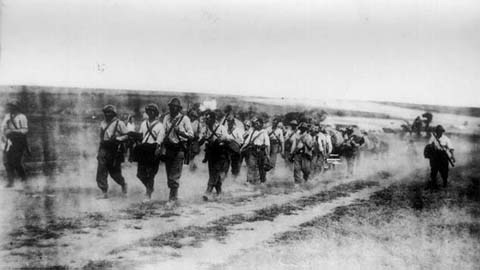 |
| Troops of Romanian 2nd Frontier Guard Regiment on the march to Odessa, 18 August 1941. |
German Panzer Group 1 (von Kleist) establishes a bridgehead across the Dneiper at Zaporozhye (Zaporizhzhia). The Soviets dynamite the Dneipr Hydroelectric Station to swell the river, causing widespread death and destruction, but the Germans get across anyway. German 50th Division reaches the Black Sea Coast at Ochakov.
Lt. Max-Hellmuth Ostermann of 7./JG 54 shoots down two Russian I-16s over Leningrad.
The Red Air Force raids Berlin with five bombers. Today is the last of a series of small-scale Red Air Force raids against the Ploesti, Romania oil fields.
 |
| "Quadruple Lewis gun on an anti-aircraft mounting, 18 August 1941." © IWM (H 12971). |
By prior arrangement between the RAF and Luftwaffe, the RAF successfully drops a spare prosthetic leg for captured RAF Wing Commander Douglas Bader while flying over St. Omer airfield. The Germans are somewhat nonplussed when the charitable gesture is followed by the RAF planes attacking the airfield.
After dark, RAF Bomber Command attacks Cologne and Duisburg. These cities both have been bombed recently so these can be considered follow-up raids.
The RAF puts 62 bombers (42 Hampdens, 17 Whitleys, and 3 Wellingtons) over Cologne. The RAF loses 5 Whitleys and a Wellington. The attack achieves little, with no casualties and only one casualty.
The RAF puts 41 Wellingtons over Duisburg, losing two planes. The weather is clear, so the attack on railway yards is a success.
There is a minor raid by 11 Whitleys and 7 Wellingtons to Dunkirk, and one training sortie over Europe, both without loss.
The Luftwaffe sends a few bombers across to raid the Tyneside and Teesside areas. These are pinprick raids that occasionally hit a populated building, tonight West Hartlepool suffers a tragedy when an ambulance depot is hit with 23 people killed and 45 injured. In addition, about 100 people are made homeless. In Norton, bombs hit a house on Benson Street, killing three people, while next door three others are killed.
David Bensusan-Butt, a civil servant in the War Cabinet Secretariat and an assistant of Lord Cherwell, chief scientific advisor to the Cabinet, submits his "Butt Report" on the accuracy of RAF bombing. The results are startling because they conclude that bombing accuracy is horrendous. Among the more prominent conclusions of the report:
- Only one aircraft of three that claims to have attacked a target actually got within 5 miles (8 km).
- Over Germany, the ratio is even worse, with only one in four bombers getting within five miles and one in ten over the industrial Ruhr river valley
- Accuracy depends upon the amount of moonlight available, with accuracy rising to two in five when there is a full moon and falling to one in fifteen during a new moon.
Fortunately for the British, they have navigational aids such as GEE, Oboe, H2S, and other navigational aids in various stages of development. In fact, today RAF Bomber Command orders GEE (the codename for a long-range navigational aid) into production at Dynatron and Cossor.
Battle of the Baltic: Soviet destroyer Statnyi hits a mine and sinks in Moon Sound off Saaremaa (Oesel).
The Luftwaffe attacks Leningrad harbor and sinks 2170-ton Soviet freighter Axel Carl.
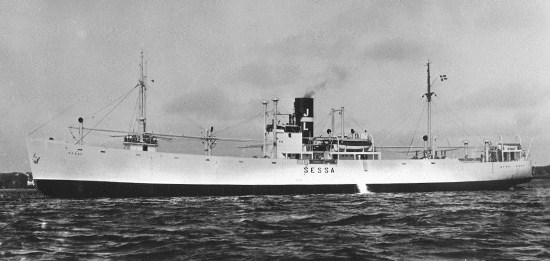 |
| Freighter Longtaker under her former name Sessa (photo courtesy of Danish Maritime Museum, Elsinore, and Uboat .net). |
This is U-38's final victory of the war, though it does go on one more patrol for an even dozen. During its time in service, U-38 sinks 35 commercial ships of 188,967 tons and damages one ship of 3,670 tons.
Royal Navy destroyer HMS Quorn its a mine between Chatham and Harwich. Quorn makes it to Chatham for repairs completed on 13 September.
Convoy HG-71 departs from Gibraltar bound for Liverpool. A Luftwaffe Junkers Ju-88 spots convoy OG-71 shortly after it leaves port and radios in its position.
Royal Navy destroyer HMS Badsworth (Lt. Commander Michael S. Townsend) is commissioned and destroyer Mahratta is laid down.
Canadian minesweepers HMCS Fort William, Kenora, and Milltown are laid down in Port Arthur, Ontario.
Free Netherlands destroyer depot ship HNLMS Columbia (Commander Cornelis Hellingman) is commissioned.
Destroyer USS Badsworth is commissioned.
U-188 is laid down.
Royal Navy submarine HMS P-33 (Lt R. D. Whiteway-Wilkinson DSC), operating off Tripoli and with 32 crewmen, disappears on or around 18 August while attacking an Italian convoy. This is one of the unsolved disappearances of submarines that are common during World War II. An Italian Cant Z501 is flying overhead and sends a ship to look for survivors that the plane's crew see in the water, but it is unclear if it sees survivors of P-33 or another ship. It is assumed by some that P-33 is destroyed by a depth charge attack by an Italian torpedo boat either today or on 23 August, but there is no confirmation of that. Nobody survives.
Royal Navy submarine P-32 (Lt. D. A. B. Abdy)is operating near P-33 and surfaces while an Italian depth charge attack is underway nearby. It is very close to the entrance to Tripoli Harbor. Lieutenant Abdy attempts to run under a known minefield to get into a better firing position but surfaces too soon and P-32 hits a mine. This sends P-32 to the seafloor at a depth of 210 feet with the entire area forward of the control room flooded, killing 8 crew. Abdy manages to escape through the conning tower hatch along with Coxswain E. Kirk, but the rest of the crew in the engine room proves unable to use their escape hatch for some reason. This is likely because an iron bar may have been welded over the rear hatch (though this is not proven). The commander of the Italian ship that picks up Abdy and his mate agrees to stick around to await more survivors, but nobody else gets out. It one of the most dramatic escapes from a submarine during the entire war, as a depth of over 150 feet is considered fatal. A total of 30 men perish.
There are still thousands of Commonwealth troops hiding out on Crete. Royal Navy submarine Torbay (Lt. Comdr. Miers) enters Messara Bay and picks up 28 British and 12 Greek soldiers. Torbay stays in the area submerged on the seafloor and enters the bay again on the 19th, picking up an additional 92 men and returning them to Alexandria.
Royal Navy submarine Tetrarch fires torpedoes into Benghazi Harbor, damaging the port boom defense.
The RAF based on Malta bombs Tripoli with five Wellington bombers.
Royal Navy destroyers Jackal and Kingston make the nightly supply run from Alexandria to Tobruk and back without incident. The relief of Australian troops is in progress, with replacement Polish soldiers landed.
The retreating Soviets scuttle freighter Volochaevka at Cherson.
Soviet auxiliary minesweeper T-503 is lost on this from unknown causes.
Propaganda: Joseph Goebbels calls President Roosevelt the "agent of international Jewry."
 |
| Finnish Ambassador Hjalmar Procope. |
US/Japanese Relations: At 16:00, Ambassador Grew meets with Foreign Minister Toyoda in Tokyo. Toyoda speaks for two and a half hours straight. He defends Japanese actions in the Pacific and denies that Japan is acting in concert with Germany and says its only objective is the settling of issues in China. For these reasons, a summit meeting between the leaders of the two powers should occur. Grew responds that the Japanese position has not responded adequately to President Roosevelt's concerns, but he will forward the Japanese request for a summit meeting to the US government with his personal support (which he does).
German/Finnish Relations: The Germans confer the Knight's Cross (Ritterkreuz) on Marshal Mannerheim.
 |
| An Italian Cant Z501, of the type that organized the rescue of the two survivors of P-32. |
The ferry system and the transport service provide direct and speedy delivery of aircraft from the ‘arsenal of democracy’ to a critical point in the front against aggression. The importance of this direct line of communications between our country and strategic outposts in Africa cannot be overestimated.Pan American Airways, Inc. quietly on 24 July has formed three subsidiaries to conduct the operations:
- Pan American Air Ferries, Inc.
- Pan American Airways Co.
- Pan American Airways-Africa, Ltd.
The ferry service supposedly derives from a request by Winston Churchill at the Atlantic Charter conference and a subsequent meeting between Roosevelt and Pan Am chairman Juan Trippe on or about 18 August 1941. However, as indicated by the earlier formation of the Pan Am corporations, the idea actually has been under consideration for some time and the conference itself is just a formality to finalize it.
 |
| "Sergeant Wacław Giermer of No. 303 Polish Fighter Squadron in conversation with a nurse while recovering in a hospital, 18 August 1941." Giermer was injured during a raid on Lille on 8 July 1941. (© IWM (HU 128141)). |
The US Marine Corps 1st Defense battalion arrives at Wake Island aboard US freighter Regulus (AK-14).
Japanese Military: The Imperial Japanese Navy requisitions 10,020-ton tanker Shinkoku Maru and puts it under the control of the Kure Naval District.
US Government: President Roosevelt signs into a law a modification of the 1940 Selective Service Act that extends the term of service of inductees from 12 to 30 months. The bill passed the House of Representatives by only one vote because there is widespread opposition throughout the country to any peacetime draft.
Congressman John Dingell of Michigan sends President Roosevelt a letter in which he proposes to take 10,000 Japanese-Americans in Hawaii as hostages for Japan's "good behavior." This is the earliest suggestion of incarcerating Japanese-Americans.
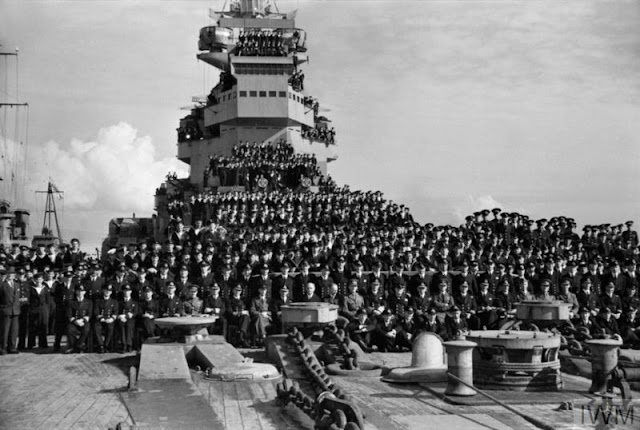 |
| "The ship's company of HMS PRINCE OF WALES poses for a photograph with Winston Churchill and his staff at Scapa Flow after the Atlantic Meeting with President Roosevelt, 18 August 1941." © IWM (A 5004). |
Burma: The Japanese have heard about the American Volunteer Group (AVG, or "Flying Tigers") assembling at Kyedaw, Burma, so they send a reconnaissance plane overhead.
Hitler orders the deportation of what remains of Berlin's Jews to the East.
The concentration camp at Amersfoort, Netherlands, opens.
Brazilian Homefront: A Lockheed 18-10 Lodestar operated by Panair do Brasil crashes into Serra da Cantareira on approach to São Paulo at night. Five of nine passengers and one of four crew members survive the crash. Note that this is one day after Walt Disney and party arrives by air at Rio de Janeiro on a goodwill trip for the US government.
German Homefront: "Swing Kids" (Swingjugend) dancing has become an underground phenomenon in the Reich, and the government is not happy at this intrusion of what it considers a decadent foreign culture. The Swing Kids listen to American and British records, tend to have long hair, dispute authority, and mock military customs such as the Hitler Salute. In general, the police forces (led by Reinhard Heydrich) see this as a dangerous infusion of "anglophile tendencies" that cannot be tolerated.
Today, the police decide to end this scourge. They send men into the clubs, arrest over 300 Swing Kids, and institute various punishments against them. These punishments range from sending the kids back to school or to concentration camps. Some boys are sent to the youth camp at Moringen and girls to the women's camp at Ravensbruck. This incites further resistance by Swing Kids who aren't captured, of course, and they begin doing anti-government acts like handing out anti-fascist leaflets.
 |
| Electrola EC 6993/ORA 4198-2. The first recording of Lili Marlen, 2. August 1939, Electrola Studio, Berlin. This label is one of the different variants that appeared during the war. The oldest label shows that the original song title was first called Song of a young sentry. (Mediatus - Eigenes Werk (own work); Digital eingelesene Platte aus meiner Sammlung) |
Joseph Goebbels hates the song and demands Radio Belgrade to stop playing it. However, Axis soldiers across the Mediterranean hear the song and love it, including General Erwin Rommel. He asks the station to continue playing the song. Goebbels, who is a friend of Rommel's, relents and allows the song to be played. The song becomes the sign-off tune of the station at 21:55 every night, and soldiers on both sides start to tune in at that moment to hear the song every night. It becomes the most famous song of the war and sells over a million copies.
Contrary to popular belief, the famous version of "Lil Marleen" is not by Marlene Dietrich, though she does record a version (retitled "Lili Marlene" in her honor) for the Morale Operations Branch of the U.S. Office of Strategic Services (OSS) in 1944.
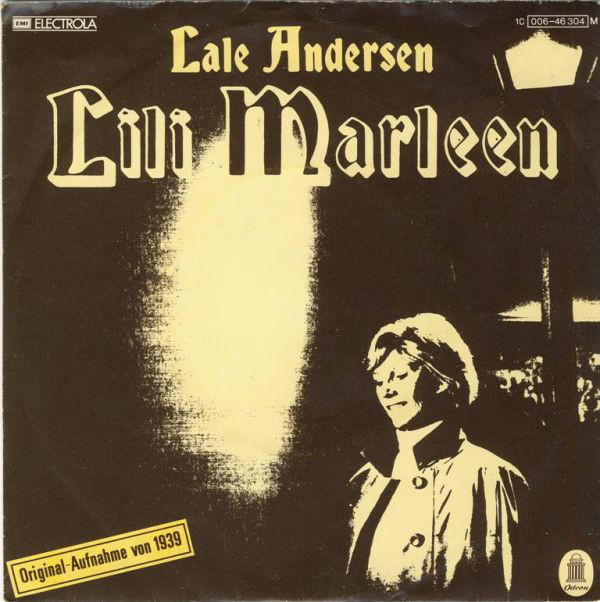 |
| Lale Andersen and her hit "Lili Marleen." |
British Homefront: The newly organized National Fire Service - which combines numerous previously independent local fire departments into one seamless organization - comes into being under Sir Aylmer Firebrace, a former London fire chief. The 118,000 men in 1400 local fire brigades, with 180,000 auxiliaries and 60,000 women, are combined into 200 "divisions" and 37 "fire forces." This became necessary because some local fire departments were refusing to come to the aid of local municipalities out of fear that their own towns might be hit. In addition, there were stories of extortion by some fire departments in exchange for providing fire services.
American Homefront: Chesty Manly, the Washington, D.C. correspondent of the Chicago Tribune, publishes a story claiming that a "leak" has informed him that President Roosevelt has plans to send an American expeditionary force to Europe. The story creates an uproar in the capital, and a vigorous debate breaks out in the press about the truthfulness of the story. It is one of several stories run by the isolationist Manly that is of questionable veracity.
The Reverend John A. O'Brien makes a radio address that urges the world to "choose the road to peace." He rhetorically asks what the warring powers have accomplished by two years of war and deplores war's futility. He concludes with a plea to President Roosevelt to put his power "into the Christ-like work of halting the brutal European strife."
 |
| Judy Garland on the cover of Animatografo, Issue no. 41, 18 August 1941. |
August 1941
August 2, 1941: Uman Encirclement Closes
August 3, 1941: Bishop von Galen Denounces Euthanasia
August 4, 1941: Hitler at the Front
August 5, 1941: Soviets Surrender at Smolensk
August 6, 1941: U-Boats in the Arctic
August 7, 1941: Soviets Bomb Berlin
August 8, 1941: Uman Pocket Captured
August 9, 1941: Atlantic Conference at Placentia Bay
August 10, 1941: Soviet Bombers Mauled Over Berlin
August 11, 1941: Rita Hayworth in Life
August 12, 1941: Atlantic Charter Announced
August 13, 1941: The Soybean Car
August 14, 1941: The Anders Army Formed
August 15, 1941: Himmler at Minsk
August 16, 1941: Stalin's Order No. 270
August 17, 1941: Germans in Novgorod
August 18, 1941: Lili Marleen
August 19, 1941: Convoy OG-71 Destruction
August 20, 1941: Siege of Leningrad Begins
August 21, 1941: Stalin Enraged
August 22, 1941: Germans Take Cherkassy
August 23, 1941: Go to Kiev
August 24, 1941: Finns Surround Viipuri
August 25, 1941: Iran Invaded
August 26, 1941: The Bridge Over the Desna
August 27, 1941: Soviets Evacuate Tallinn
August 28, 1941: Evacuating Soviets Savaged
August 29, 1941: Finns take Viipuri
August 30, 1941: Operation Acid
August 31, 1941: Mannerheim Says No
2020

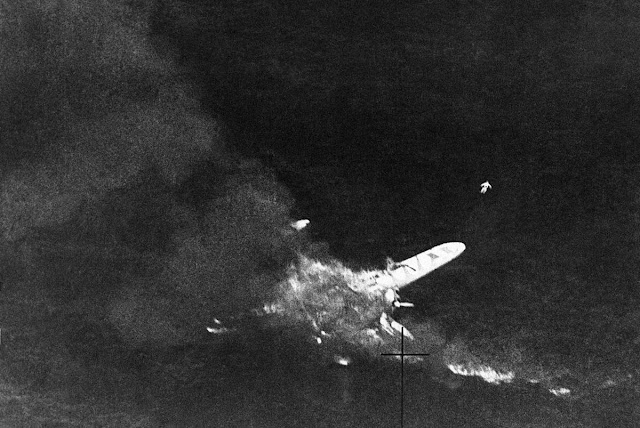
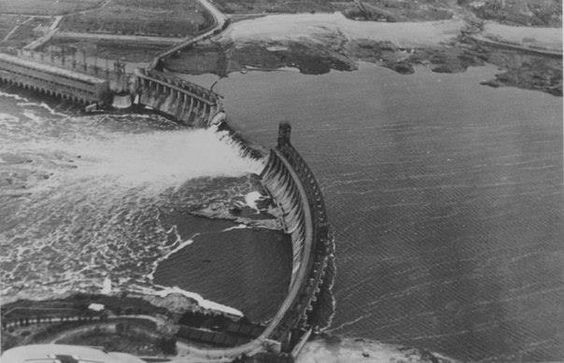
No comments:
Post a Comment